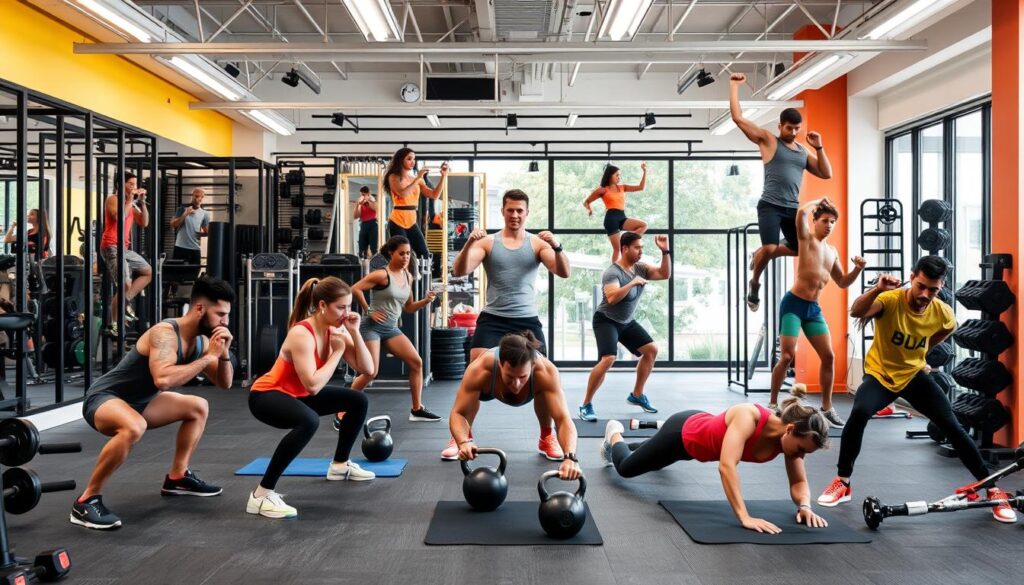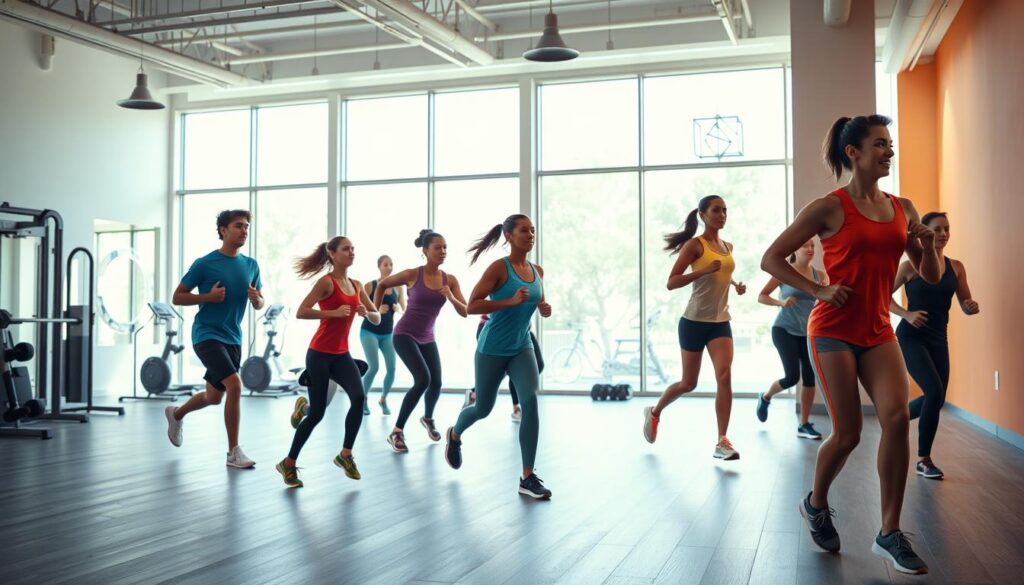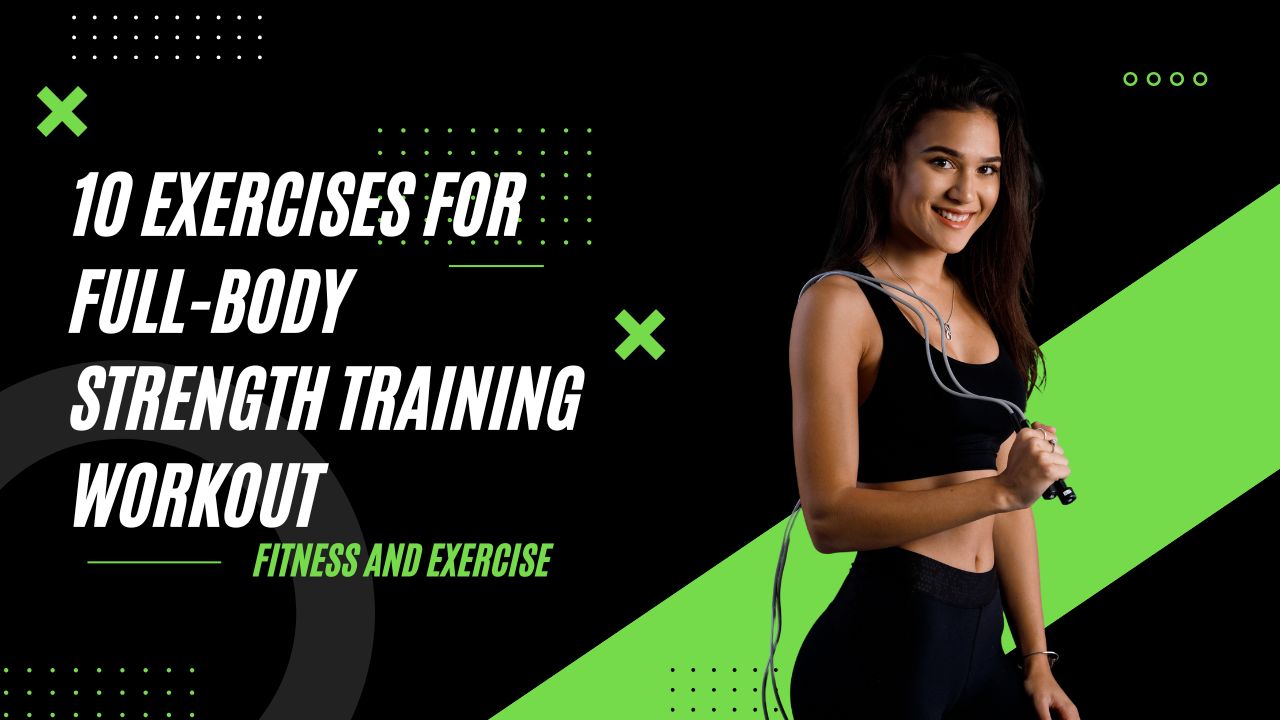Did you know a full-body workout can increase your metabolism by up to 20%? Our guide covers strength training exercises for all major muscle groups. It’s perfect for both newbies and fitness buffs.
A good strength training program is key for fitness. It helps build muscle, boosts heart health, and improves flexibility. These exercises are flexible and fit well into any workout plan.

Table of Contents
Key Takeaways
- Integrating a full-body workout can significantly boost metabolism.
- These exercises offer benefits for both beginners and experienced gym-goers.
- A full-body workout ensures balanced muscle development.
- Adapt these exercises to various fitness levels to maintain an effective fitness regimen.
- Target all major muscle groups with our strength training program for comprehensive results.
Benefits of Full-Body Strength Training
Full-body strength training offers many health benefits. It works out multiple muscle groups at once. This boosts muscle gains, improves body mobility, and enhances cardio fitness.
Improved Muscle Mass
One key benefit is better muscle mass. By using progressive overload, we make our muscles stronger. Regular strength training helps us build muscle and look toned.
Enhanced Cardiovascular Health
Strength training also improves heart health. It raises our heart rate, which is good for our heart. Compound movements work many muscles at once, making our heart healthier.
Increased Flexibility and Balance
Full-body workouts also improve flexibility and balance. They work out many muscles, making us more flexible. This reduces injury risk and improves posture. It also helps us do better in sports and daily activities, leading to a healthier life.
| Health Benefit | Description |
|---|---|
| Improved Muscle Mass | Utilizing progressive overload techniques to increase muscle gains and enhance overall body composition. |
| Enhanced Cardiovascular Health | Accelerating heart rates through compound exercises for better cardio fitness and heart health. |
| Increased Flexibility and Balance | Promoting greater flexibility and balance, leading to fewer injuries and improved daily performance. |
Essential Equipment for a Full-Body Workout
To create a full-body workout at home, you need the right gear. Whether you’re setting up a new gym or improving your current setup, the right equipment makes a big difference. Here, we’ll look at some key tools and their benefits.
Free weights, like dumbbells and kettlebells, are crucial. They’re great for many exercises and help build strength and muscle. Using them regularly boosts your fitness.
Resistance bands are also essential, especially for those with little space or money. They’re easy to store and do many exercises. They’re perfect for targeting specific muscles or for full-body workouts.
Barbells are vital for serious lifters. They allow for heavy lifting, which is key for growing muscles and getting stronger. Exercises like squats and bench presses are best done with barbells.
Kettlebells are great for those who like to mix up their workouts. They’re used in dynamic exercises that improve endurance and coordination. Exercises like the kettlebell swing are great for this.
Choosing the right equipment depends on your goals, space, and budget. For example, if you have little space, consider resistance bands and adjustable dumbbells. If you have more room, you might want a full set of free weights and a barbell.
There are also space-saving alternatives like foldable benches and compact multi-gym systems. For those who prefer bodyweight exercises, a pull-up bar and a workout mat are very helpful.
| Equipment | Function | Benefits |
|---|---|---|
| Free Weights | Strength Training | Increases Muscle Mass, Versatility |
| Resistance Bands | Strength & Flexibility | Portable, Affordable |
| Barbells | Heavy Lifting | Muscle Growth, Power |
| Kettlebells | Dynamic Exercises | Endurance, Coordination |
Having a variety of strength training tools and equipment is key for a well-rounded workout. It helps us reach our fitness goals efficiently.
10 Exercises for a Comprehensive Full-Body Strength Training Workout
Doing a mix of upper body, lower body, and core exercises can really boost your fitness. Let’s explore ten key exercises that are the heart of a full-body strength training routine.
Squats
Squats are key for your lower body, working your quads, hamstrings, and glutes. Stand with your feet shoulder-width apart, then lower your hips as if sitting in a chair. Keep your chest up and knees over your toes. Push through your heels to stand up again. You can try goblet squats or split squats for different levels of challenge.
Bench Press
The bench press is a must for your upper body, focusing on your chest, shoulders, and triceps. Lie on a flat bench, grip the bar wider than your shoulders, lower it to your chest, and then press it back up. Try incline or decline bench presses to work different chest areas.
Deadlifts
Deadlifts are crucial for your back, glutes, and hamstrings. Start with your feet apart, grip the bar just outside your knees, lift it up by straightening your back and legs, and stand up fully. Lower it back down to start. You can try Romanian or sumo deadlifts for different levels of difficulty.
Pull-Ups
Pull-ups are great for strengthening your upper body, especially your lats and arms. Hold an overhead bar, pull up until your chin is over the bar, and then slowly lower back down. If you’re new, use assisted machines or resistance bands.
Planks
Planks are excellent for your core. Start in a push-up position but rest on your forearms. Keep your body straight, avoid sagging hips, and hold it. Side planks can add more challenge to your core workout.
Rows
Rows work your back, biceps, and shoulders. Do bent-over rows by leaning forward at the hips, pulling the weight to your chest, and then lowering it back down. Try T-bar rows or seated cable rows for different intensities.

Lunges
Lunges are dynamic for your lower body, targeting your quads, hamstrings, and glutes. Step forward with one leg, lower your hips until both knees are bent, and then stand up. You can try reverse lunges or walking lunges for more variety.
Overhead Press
The overhead press is key for your upper body, focusing on your shoulders and triceps. Stand with your feet apart, grip the bar at shoulder level, press it overhead, and then lower it back down. Dumbbell presses and military presses are good alternatives.
Bicep Curls
Bicep curls are essential for arm strength, mainly targeting your biceps. Hold dumbbells, curl them to shoulder height, and then lower them back down. Try hammer curls or concentration curls for different workouts.
Tricep Dips
Tricep dips are vital for your upper arms, focusing on your triceps. Sit on a bench or parallel bars, lower your body by bending your elbows, and then push back up. Elevate your feet or add weights for more challenge.
Here’s a structured look at the key exercises covered:
| Exercise | Primary Muscles Targeted | Variations |
|---|---|---|
| Squats | Quadriceps, Hamstrings, Glutes | Goblet Squats, Split Squats |
| Bench Press | Pectorals, Deltoids, Triceps | Incline Press, Decline Press |
| Deadlifts | Back, Glutes, Hamstrings | Romanian Deadlifts, Sumo Deadlifts |
| Pull-Ups | Lats, Arms | Assisted Pull-Ups, Resistance Bands |
| Planks | Core | Side Planks |
| Rows | Back, Biceps, Shoulders | T-Bar Rows, Seated Cable Rows |
| Lunges | Quads, Hamstrings, Glutes | Reverse Lunges, Walking Lunges |
| Overhead Press | Shoulders, Triceps | Dumbbell Presses, Military Presses |
| Bicep Curls | Biceps | Hammer Curls, Concentration Curls |
| Tricep Dips | Triceps | Feet Elevated, Weighted Dips |
Importance of Warming Up Before Exercising
Before starting a tough full-body strength training session, warming up is key. It prepares us for better performance and helps prevent injuries. A warm-up gets our muscles and heart ready for the workout.
A good warm-up includes dynamic stretches and light cardio. Dynamic stretches like leg swings and arm circles boost flexibility and get muscles ready. They’re better than static stretches, which can slow you down before working out.
Adding light cardio, like jogging or jumping jacks, raises blood flow and heart rate. This helps our muscles get the oxygen and nutrients they need for hard work.
The warm-up’s length and intensity depend on the workout. For a full-body strength training, 5 to 10 minutes is enough. This prep not only prevents injuries but also boosts muscle activation and workout performance.
Don’t skip the warm-up. By doing dynamic stretches and light cardio, we prepare our bodies for the workout. This makes our workout more effective and keeps us safe from injuries.

Nutritional Tips to Complement Your Workout
Getting the right nutrition is key to better workouts. Here are some tips to help you recover faster and reach your fitness goals:
Protein-Rich Diet
Eating enough protein is vital for muscle repair and growth. Add lean proteins like chicken, fish, tofu, and beans to your diet. Eating protein within 30 minutes after working out helps your muscles heal and grow faster.
- Chicken breast
- Salmon
- Eggs
- Lentils
- Quinoa
Hydration
Drinking enough water is important before, during, and after exercise. Water helps keep your energy up and prevents dehydration. Try to drink 8-10 glasses of water a day, more when you’re working out hard.
Post-Workout Nutrition
After your workout, eat a mix of proteins and carbs. This helps your body recover and rebuild. Good choices include a protein shake with banana, Greek yogurt with berries, or a turkey sandwich.
- Protein shake with banana
- Greek yogurt with berries
- Turkey sandwich with whole-grain bread
By following these nutrition tips, you’ll support your strength training. This will lead to better performance and results in your workouts.
Conclusion
As we wrap up our guide to full-body strength training, it’s clear that these exercises bring big benefits. They boost muscle mass, heart health, and flexibility. Using dumbbells, barbells, and bands makes our workouts more varied and effective.
The exercises we’ve covered, like squats and deadlifts, work many muscles at once. They help us build a strong, balanced body. Remember, warm-ups and good nutrition are crucial for success.
Sticking to our workout plan is essential for reaching our goals. Regular exercise and tracking our progress keep us motivated. Let’s use the tips from this article to improve our health.
Our fitness journey is ongoing. Following these workout and nutrition tips will help us reach our goals. Stay dedicated and let’s improve our health together.
FAQ
What are the benefits of a full-body workout?
Full-body workouts improve muscle mass and heart health. They also boost flexibility and balance. This balanced approach enhances overall strength.
What equipment do I need for a full-body strength training program?
You’ll need free weights, resistance bands, and barbells for a full-body workout. Kettlebells and other tools are also helpful. You can also use space-saving options and bodyweight exercises.
Can beginners do full-body strength training workouts?
Yes, full-body workouts are great for beginners and experts alike. They can be adjusted to fit different fitness levels and preferences.
How do I perform squats correctly?
Stand with feet shoulder-width apart for squats. Lower your body as if sitting in a chair. Keep your chest up and push through your heels to stand up. Proper form is key for safety and effectiveness.
Why is warming up important before exercising?
Warming up prevents injuries and prepares your body for exercise. It boosts blood flow and heart rate. This makes your workout safer and more effective.
What are some effective post-workout nutrition tips?
Eating protein-rich foods after working out helps with muscle recovery. Stay hydrated and balance your macronutrients. Include lean meats, dairy, nuts, and veggies for the best recovery.
How can I stay motivated to achieve my fitness goals?
Set realistic goals and track your progress to stay motivated. Find a workout routine you enjoy. Consistency and variety make fitness exciting and rewarding.





